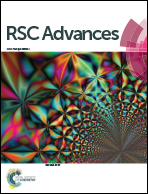Site isolation and coordination control of a transition metal ion by molecular surface engineering in mesoporous silica: the case of a bio-inspired copper–polyamine grafted complex†
Abstract
A bio-inspired polyamine copper complex with an open coordination for potential applications in oxidation catalysis was homogeneously grafted in the nanopore of a mesoporous MCM41-like silica. This was achieved using partial surface silanol capping by trimethylsilyl functions in the presence of a molecular stencil pattern (MSP) that masks the surface. This mask was then withdrawn to graft the tridentate polyamine ligand which provokes substantial de-capping in its vicinity. Before complexation by Cu(II) ions, the surface was capped again for a better control of the hydrophobicity, which incidentally prevents not only adsorption of copper onto silanol but also copper pairing for a high level of MSP controlled organic coverage. Concomitantly, a surprising competition of copper with its own counterion for complexation to the grafted polyamine appears. This effect is more pronounced for triflate (F3CSO3−, Tf−) than chloride (Cl−), causing the former to be better for site isolation. The copper coordination quantitative analysis of both monomeric and dimeric species is based on a combined EPR and EXAFS investigation.


 Please wait while we load your content...
Please wait while we load your content...